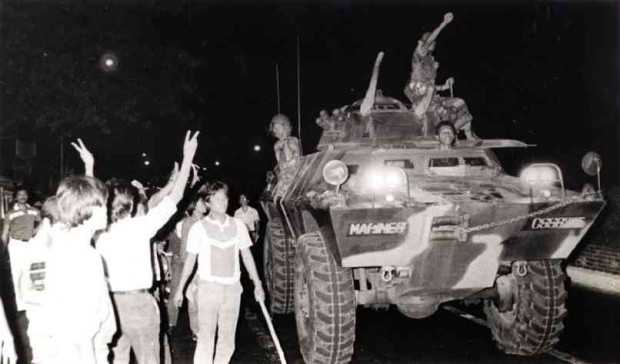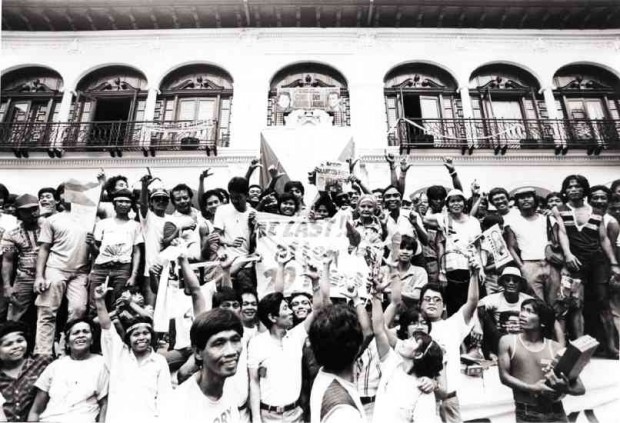Little known book bares US, Clark role in revolt

SOLDIERS loyal to the late dictator Ferdinand Marcos position a tank near Malacañang just a few hours before the Marcoses fled as the People Power Revolution of February 1986 forced the family that had ruled the country for more than 20 years to abandon the place they had called home for so long. INQUIRER PHOTO
A LITTLE known book published by a US Air Force unit contained small details that reveal the extent of the US government’s role in the 1986 Edsa People Power revolt, including the planning for the evacuation of the late dictator Ferdinand Marcos from Malacañang to Clark Air Base on his way to exile in Hawaii.
While mementos of the revolt have long been missing at the Clark Museum in the former US air base, a book published by the US Air Force unit that evacuated Marcos and his party from Malacañang on Feb. 25, 1986, contained details, or at least a version, of that historic exit.
Pictures of Marcos’ hasty arrival in Clark and departure for Hawaii have not been released until now, years after the Philippine government converted the air base into an economic hub in the aftermath of the rejection by the Philippine Senate of a treaty that would have extended the stay of US bases in Clark and Subic.
The US 13th Air Force (13AF) shared its account in the chapter, “February 1986 Revolution,” in the fourth edition of “An Annotated Pictorial History of Clark Air Base: 1899-1986.”
The 13AF is integral to the US Pacific Air Force as a unit that is always “combat-ready, fully supplied and capable of instant mobility.”
Article continues after this advertisementThe book was put together by the 13AF’s Office of History and written by its chief, David L. Rosmer.
Article continues after this advertisementOnly edition
It was circulated mostly in the military, never seeing print again after its publication in 1986.
Ceferina Yepez, who served as national affairs adviser to a succession of 13AF commanders since 1949, used to have three copies of the book before the Philippine Senate rejection of the bases in 1991.
“All my copies were borrowed and never returned,” she said. Her only copy now is donated in 2014 by Col. David Richardson, who served as an executive officer of a commanding general.
Yepez, former curator of the Clark Museum, considers the book valuable for its rare photographs and survey maps, some dating as far back as 1902 when the US established Clark as the Fort Stotsenburg base for cavalry horses.
Like the museum, the book carried no snapshots of Marcos’ stay in Clark, probably his second visit to the base since he raised the Philippine flag in Clark on Feb. 16, 1979, when the Philippines regained sovereignty over the base lands.
The chapter ended with this note: “Although there were photographs taken during Marcos’ brief stay at Clark [Air Base], they have not been cleared for release outside official US agency by the State Department.”
Rosmer narrated the events leading to the bloodless revolt, opening the account with “For 20 years, Ferdinand and Imelda Marcos had been virtually synonymous with the Philippines.”
That was until the assassination of Sen. Benigno “Ninoy” Aquino Jr. on Aug. 21, 1983, the snap election that Marcos called against Aquino’s widow, Corazon, on Feb. 7, 1986, the breakaway of Defense Minister Juan Ponce Enrile and Armed Forces vice chief of staff, Lt. Gen. Fidel V. Ramos, from Marcos on Feb. 22, and the massing up of people on Edsa following Jaime Cardinal Sin’s appeal to protect the two officials.

PEOPLE power spills over into the grounds of Malacañang Palace on the day in February 1986 when the late dictator Ferdinand Marcos, his family and closest cronies fled the country through Clark with the help of US Air Force troopers and aircraft. INQUIRER PHOTO
‘Two presidents’
Rosmer recalled that “on Tuesday, Feb. 25, the Philippines had two Presidents. Marcos in Malacañang and Cory at Club Filipino. Most of the AFP (Armed Forces of the Philippines) had switched to the rebel side and loyalist forces from the North, under Brig. Gen. Tomas Dumpit, who supposedly were on their way to attack Enrile and Ramos, never materialized.”
US President Ronald Reagan, Rosmer continued, “clearly had thrown his support to Aquino and the best could be hoped for was to beat a safe retreat.”
“Both US Ambassador Steven Bosworth and The Joint US Military Assistance Group (Jusmag) Brig. Gen. Theodore Allen were in communication with Malacañang and Clark, as well as Washington,” said Rosmer in the book.
“There was haste. The decision to evacuate Marcos to Clark,” according to Rosmer, “was made later in the afternoon of Feb. 25. Five helicopters from Clark’s 31st Aerospace Rescue and Recovery Service (ARRS) flew south to Malacañang to get Marcos and his family, arriving at the base just after 9 p.m. on the same day.”
Rosmer wrote: “Clark’s most significant role, of course, was the evacuation of President Marcos, his immediate family and several advisors and confidants, including General [Fabian] Ver and Eduardo Cojuangco.”
Planning the evacuation, he said, “began at the US Embassy once President Reagan’s warning to Marcos against the use of force was received, but it was some time before the plan was accepted at Malacañang.”
Planning the mission at Clark, he said, “began on the morning of February 25, by which time Lt. Col. Robert Stankovich’s 31ARRS maintenance crews were frantically trying to ready every available helicopter for service (five were prepared).”
Original plan
The original plan was to evacuate Marcos and his party from the Palace grounds, which was revised because thousands of civilians had massed up around Malacañang. A site across the Pasig River was used.
“This caused some delay, some anxious moments, and a little confusion, but eventually everything came together and President Marcos’ party was taken out without incident on the first two helicopters,” Rosmer said.
Maj. Gen. Gordon Williams, 13AF chief, and Allen, rode the first two choppers because “Washington considered Marcos’ safe evacuation to be critical,” he said.
‘Considerable cargo’
Two other helicopters “extracted eight people and a considerable amount of cargo.” The cargo contents were not disclosed.
With Marcos in Clark, additional security problems cropped up because the Clark Air Base Command of the Philippine Air Force, set up in Clark in 1979, had defected to the rebels or lived at the base.
The refugees, as Marcos and his party had been described, were first received at the headquarters of the 3 Tactical Fighting Wing (3TFW) of the US Air Force.
“Key 13AF and 3TFW personnel greeted the party and tried to make each individual as comfortable as possible under the circumstances,” wrote Rosmer.
Overnight stay
“Meanwhile, Washington had to be consulted as to what course of action was to be followed. Eventually, the decision was that Marcos and his group would remain overnight and leave Clark the next morning. Later, this decision was amended to ‘dawn,’” Rosmer continued.
He said Marcos, Imelda, their children and Ver were moved to the 13AF Distinguished Visitor Quarters. Yepez said this was the stately house beside the White House, the official residence of Philippine presidents in postbases years.
The rest of the group stayed at Chambers Hall (now the Holiday Inn), requiring residents to sleep elsewhere in the meantime.
“Not long after the group finally got settled in, the decision came from Mrs. Aquino, via Washington, that Mr. Marcos should leave as soon as possible, and the entire process had to be repeated,” Rosmer said, adding that Cojuangco and some members of his family arrived in Clark, joining the evacuation.
“Along with the Marcos party, Clark AB personnel packaged up and sent out a considerable amount of ‘personal effects’—the same ones that later were seized by US Customs officials in Hawaii and which became the subject of so much media controversy,” Rosmer wrote.
Judgment withheld
“As they had done throughout the entire period of the revolution, key US personnel at Clark withheld moral judgments with regard to these ‘personal effects’ and simply followed instructions from Washington,” Rosmer said. He gave no information on what these were or how much these were valued.
Despite this mission, Rosmer clarified that US military forces “adopted a policy of strict neutrality and noninvolvement.”
Explaining the absence of US aircraft during the uprising, he said most of these were deployed elsewhere while the Clark runway was undergoing repair. Many troops and aircraft went to Korea for a military exercise.
While the Subic Naval Base in Zambales was sealed off from the rebels because the command and local government were “pro-Marcos,” Angeles City supported Aquino.
At the end of People Power I, Clark became safe haven to PAF’s 6 T-28s, 5 T-33s, 7 F-8s, 2 F-47s, 2 C-130s, 11 F-5s, 1 MD-500 and 2 Twin Otters.
Rosmer admitted that Clark was prepared to deter loyalist forces, saying that “at any rate, USAF (United States Air Force) forces at Kadena (Japan) and USN (United States Navy) aircraft were ready to support Clark if it became necessary.”
The last task of US military personnel in Clark was to sweep Malacañang clean of mines and explosives, he said. People Power I, Rosmer said, “caused hardly a ripple in the base’s normal day-to-day activity.”
Cory’s desire
As to Marcos’ allegation that he was duped by US officials that he would be flown to his home province of Ilocos Norte, Rosmer said: “While all the facts certainly are not known, it appears that this claim remains only that.”
“For her part, Mrs. Aquino has made no secret of the fact that she wanted the US to engineer Marcos’ departure from the country and that she conveyed that message to the American authorities who approved the evacuation,” he added.
Rosmer hinted that more pieces of information are still out there, saying, “much remains to be written about the February revolution and the small, but important role that CAB (Clark Air Base) personnel played in it.”